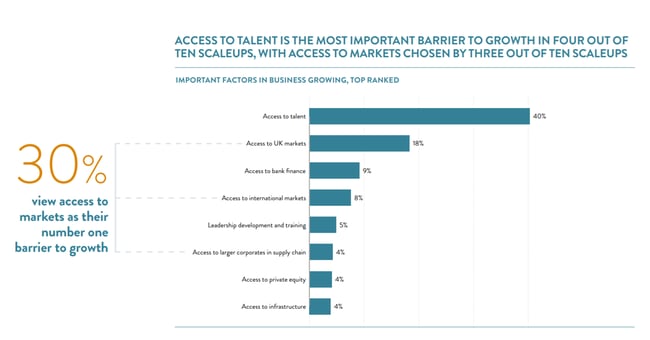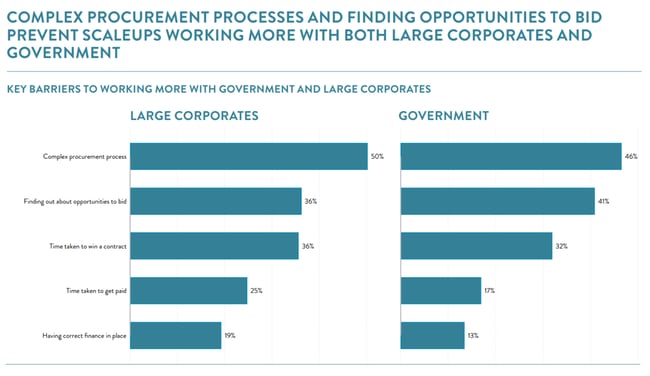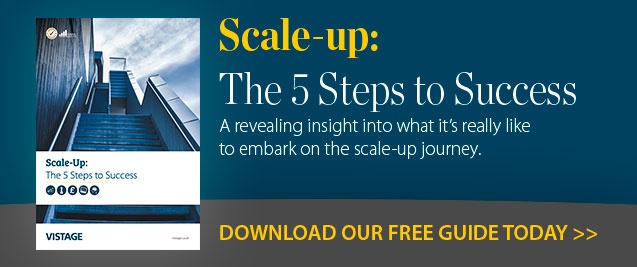Growth is ultimately the goal for every business, but some grow faster than others. A scaleup business is defined as one with an average annualised return of at least 20% in the past three years, with at least ten employees at the beginning of the period.
20% growth every year for at least three years sounds like dreamland, but with such momentum comes vast challenges. 35% of Vistage’s members are scaleups, so our Chairs have more insight than most into these challenges, and how to successfully overcome them.
We caught up with two of them—Jo Macsween and Steve Gilroy—to assess the five biggest challenges for scaleups as laid out by the ScaleUp Institute's Annual Scaleup Review 2018—talent, finance, markets, leadership capacity and infrastructure.
Jo Macsween is the former CEO of the leading international haggis manufacturers that carries her name and was instrumental in taking the business from a butcher’s shop to an award-winning food brand. Steve Gilroy has led businesses ranging from £2m to £100m and has completed multiple successful acquisitions and exits. He launched Vistage’s first scaleup group a few years ago. Here’s what they had to say.
Talent & skills
In 2015, the Employer Skills Survey reported that 25% of vacancies went unfilled due to a lack of adequately skilled applicants. In addition to the skills shortage, the rate at which scaleups create positions is three times that of FTSE100 companies. This combination creates a serious challenge for scaleup companies — one which their leaders need to handle with careful strategic planning.
Jo Macsween believes a good place to start is with shifting priorities and changing your perspective on hiring: “Often I hear leaders agonising about investment decisions to do with capital expenditure or new markets, but they don’t agonise as much about the next important person they’re going to hire or fire.
“Business see people as an overhead, but they should really sit on the balance sheet; if your building burns down but all your people survive, your ability to recover would be pretty fast. If the opposite happened, you wouldn’t have a business.”
Another important factor is timing. When should you hire new people? According to Macsween, waiting until you desperately need someone could mean you’ve left it too late: “When it comes to talent, you need to get people almost before you need them. It’s often seen as a hefty investment, and that scares people. It’s like buying a school uniform for a kid. A smart parent will buy something a size or two bigger so they grow into it. A scaleup, too, needs to invest in the future of the business, not the here and now. If you get the right people, they will help you with the pace of growth, and with the strategy of how to get there.”

One of the toughest areas when it comes to talent is being honest about your skills and the abilities or fit of current staff or board members. Determining what you’re good at and what you need to delegate is vital to ensuring your business continues to grow. As Jo says: “A leader often needs to step out of their own way to recognise where their skills are and, more importantly, where they’re lacking. The business may well move faster if they get out of the way and let other people do it.”
Business leaders have to apply the same philosophy to everyone in the company. Are the people who’ve been there from the start still the right people to take the company forward? As Jo highlights, this decision can be difficult and emotive, but it’s crucial nevertheless: “Keeping people who have been there from the start but are no longer the right people for the next chapter can be a problem. This is something I’ve been aware of through Chair conversations—you feel torn as a human being because of that loyalty and emotion, but just because people have got you to this stage, it doesn’t mean they’re going to be right for the future.”
Jo believes Vistage groups can make a big difference when it comes to this challenge: “This is where the power of a peer group can help. Difficult questions can be asked to help leaders tackle the issue head-on, such as ‘What are you avoiding?’ or ‘What are you pretending not to know?’”
In a competitive marketplace, recruiting the right people is also about ensuring your company is attractive to potential employees. Defining the purpose of your business, creating a healthy, positive workplace culture and offering fair incentives can all help you attract and retain the best talent.
Jo feels successful scaleups “take time to think about their talent pipeline and their brand as a holistic thing. You have to ask: ‘is our brand attracting talent’, ‘are we keeping people?’ It’s not just about choosing someone—it’s about mutual selection.”
The talent, as Jo says, is there. But it’s down to the scaleup business leader to assess the areas that will help the business maintain growth, and create a place where the best talent wants to work.
Finance
The 2018 ScaleUp Institute Annual Scaleup Review found that the majority of scaleup businesses lacked a clear understanding of their finance options, and 70% believed accessing bank loan finance would be a barrier to growth. So is this mere perception or a reflection of the truth?
As Steve says: “It’s not that there is no finance available. It’s about being educated about all the different options. Many businesses embark on the first option presented to them without exploring alternatives. What is the finance for? Is it to buy equipment? To open up new stores? To launch into a new international market? You need to determine which type of finance option is most appropriate.”
There are many funding options for scaleups but to improve chances of receiving funding, scaleup businesses need to make themselves attractive to investors—and it’s not all about the number of zeros on the balance sheets.
Investors will always be interested in businesses with a sustainable scaleup strategy. It’s not about showing how far you’ve come, rather proving that growth will continue and how you intend to achieve that growth. Potential investors want to see agility, innovation, vision and a clear strategy. Part of this is necessarily identifying weaknesses or skills gaps and how you plan to address these issues.
When it comes to managing finance challenges in scaleup businesses, Steve Gilroy thinks you should start by looking at what he calls the sixth scale up challenge: business model fundamentals. He believes that before you start scaling up, it’s vital to look at your business model and, if necessary, make changes to how you position your business or how customers buy your product.
“A leader often needs to step out of their own way to recognise where their skills are and, more importantly, where they’re lacking"
- Jo Macsween
“Businesses tend to go straight to scaling up the business they’ve got: They’ve got this far, and experience fantastic momentum, so why change things? This happens for two reasons. One is because they’re too busy working in the business to step back and look at the bigger picture. The second is that the ongoing growth seems obvious, do more of the same.
“While this is understandable, it means they could end up missing opportunities to create a business that could grow faster, borrow less or generate more cash.”
As Steve explains, failure to examine how and when cash is received could make a big difference to a company’s borrowing and—ultimately—its growth: “Some members [Steve runs a Vistage scaleup group] have found that by changing their cash strategy, they can move faster with less borrowing.
“Here’s a crude example: If a business sells hardware, customers buy it, and you send them an invoice which they’ve got up to 90 days to pay. So that’s a 90-day gap. You’ve had to buy raw materials, pay for a factory and pay for the people in the factory. All of these are upfront costs. Changing this model to customers paying upfront and building to order means you get cash in the bank before you build. Instead of chasing cash, you get the cash first which means you don’t have to borrow.
“I’ve worked with businesses who thought they would have to borrow £2-3 million to maintain momentum whereas adopting a different strategy—a new business model—they’ve been able to maintain growth without borrowing at all.”
Markets
One of the biggest challenges facing scaleups is the need to access new markets and acquire new customers to maintain growth momentum. Whether you’re trying to expand into new local markets or expand overseas, there are many obstacles to consider such as increased financial risk, logistics and regulatory issues. You need to expand but what if you take on too much, too soon?
Jo believes it’s important to say no sometimes: “Sometimes companies say yes to everything because they need the money. In a way that’s very exciting but it can mean you lose focus. You have to consider: is this the right fit? Are we chasing the wrong business? It’s about sales prioritisation.”
Once you’ve prioritised what your objectives are, the next step is clearly defining your audience. Steve believes this is vital: “When people define their markets, they’re often too wide, they’re not specific enough. There isn’t enough customer profiling or defining their ‘ideal customer’, and therefore they attempt to sell their product to the whole world.

“That’s how they miss appealing to the real audience. In our [Vistage] groups, we work to help leaders define exactly who has a need for their product or service. The more work you do on this upfront, the faster your sales cycle.”
On the flipside, many business leaders think they’ve exhausted opportunities in their home market and look international early. Internationalisation is a great way to maintain growth momentum—66% of scaleups interviewed by the ScaleUp Institute operate internationally after all—but audience analysis can often throw up other opportunities. Again, the key is in research.
Eventually, however, going abroad is a natural next step for a scaleup, and when it comes to expanding overseas, Steve suggesta using networks and finding partners to mitigate risk and improve your chances of success: “For most people, either within their business network or in a community like Vistage there are potential strategic partnerships. You can use your contacts to gain knowledge on certain markets, the culture, the dos and don’ts.
“Learning as much as possible about specific markets can help you decide whether or not it’s the right move and how you can enter that new market.”
Leadership capacity
The demands on a scaleup business leader naturally evolve: growing pains are real. In the outset, the business leader will likely take on a lot of responsibility themselves, whether that’s finance, recruitment, sales or all of the above, and more. However, successfully scaling up relies heavily on recognising that you may need help to develop new leadership skills.
Jo MacSween believes you need to start by “having the honesty, humility and vulnerability to admit what you know and what you don’t know.
“This is often what brings people to Vistage: They’ve come to a crossroads—either they’ve grown the business to a point, and it’s getting much more complicated. Or they have more employees. Or they’re looking at new markets. Or all three. They know they need some other opinions and perspectives, but they’re not sure if that means they should get a board or some non-execs—they’re just aware that they don’t have all the answers. That’s why humility is needed.”
“Time out or working ‘on’ instead of ‘in’ the business can produce better results—not just for the business but for the individual too"
- Steve Gilroy
Steve Gilroy feels leaders can gain a clearer perspective from stepping out and looking in at the business: “Time out or working ‘on’ instead of ‘in’ the business can produce better results—not just for the business but for the individual too. The challenge is getting people to realise that. When businesses are scaling-up, everyone’s very busy, but they could be busy doing things wrong or inefficiently. When you step out you gain clarity.”
Infrastructure
Whether it’s problems with technology, planning laws or business premises, for scaleup businesses, managing changing infrastructure can be a significant pain point. However, there are simple solutions for many of these problems — and a lot of it comes down to changing your mindset.
“It’s about using things like cloud technology and a flexible workforce, rather than saying ‘we’ll need offices in Manchester and Edinburgh, 55 new permanent recruits and a new sales team.’ It’s about being agile. Yes, you’ll need people and facilities, but you don’t need to take the traditional route of thinking you need to own all this stuff.”
Scaling up in this way can decrease costs, minimise risk and reduce planning time. As Steve explains: “Fractional services like part-time directors and flexible facilities enable fast growth and high growth. If you have to get a five-year lease on a new office in Paris, it slows you down and adds tremendous costs. You don’t have to do any of that—there are much more flexible models for scaling up now.”
When it comes to scaling up your business, many of the challenges leaders face are the challenges all companies face. In a scaleup, however, they all come fast and at once. The key, as with most things, is planning and preparation. By taking a strategic approach to scaling up your business and getting the business fundamentals right, you can turn the challenge into an opportunity for further growth.
Vistage has been endorsed by The ScaleUp Institute as a key programme for helping business leaders improve their leadership skills and grow their businesses. You can read the full report here.

